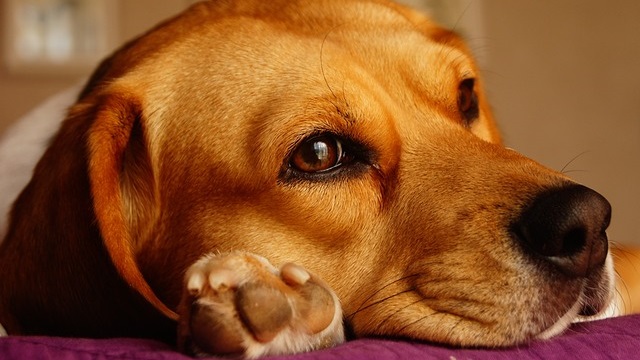Why Do Dogs Lick Their Paws? What Itching Could Signal
Why do dogs lick their paws so much, and when should you worry? After all, it is a common sight. Your pooch sprawled on the couch, tongue working away at their feet. Nothing too unusual about it. One may think it is to clean themselves. Nothing more than a bit of dirt or a ticklish blade of grass. But when licking becomes frequent or intense, it can hint at allergies, skin infections, or even underlying pain.
In this article, we’ll explore what persistent paw licking might signal, drawing on veterinary insights to help you spot the difference between harmless habits and warning signs.
Key Takeaways:
- Occasional paw licking is normal grooming.
- Persistent licking can signal health issues.
- Check for injuries, skin problems, parasites, or allergies.
- Home care is only safe if no infection is present.
- Behavior tracking tools help catch problems early.
Why Do Dogs Lick Their Paws?
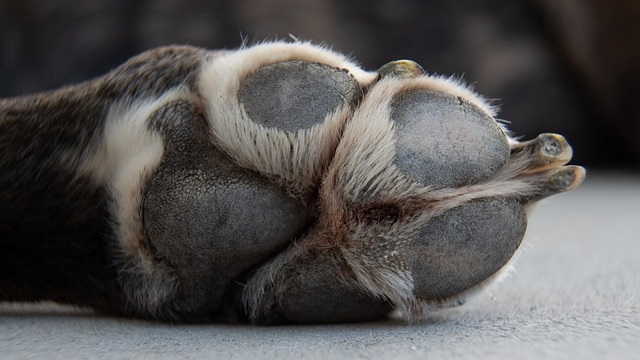
Dogs lick their paws for several reasons, including:
- Grooming
- Injuries or pain
- Skin condition
- Parasites
- Allergies
- Behavior issues
Occasional licking is perfectly normal since it’s a natural way for them to clean themselves and remove small irritants. However, when the licking becomes frequent, intense, or focused on a particular paw, it can be a sign that something else is going on.
According to vets, persistent paw licking can stem from discomfort, skin irritation, allergies, parasites, or even boredom and stress. Yes, dogs get bored too. The tricky part is distinguishing harmless quirks from warning signs, so let’s see what constitutes normal behavior and what can be a sign of trouble.
Common Reasons for Dog Licking Paws
Now that we have identified grooming, injuries, skin issues, parasites, allergies, and behavior as the most common reasons for dogs licking their paws, let’s delve a bit deeper into each one.
Grooming
A dog licking its paws is a sign that usually appears after walks or play. It’s their way of getting anything that could have stuck there out of the way. With their tongues, they clean off all the dirt and debris, so there is nothing to worry about.
Injuries or Pain
Licking can be a dog’s way of easing discomfort from minor injuries that are easy to miss. Common culprits include:
- Dry, cracked paw pads – These can be a result of walking on hot pavement or rough surfaces, so it’s best not to take your dog outside in the sun.
- Minor cuts or abrasions – Sharp stones and rough terrain can easily cut the paw pads. Even blades of grass have been known to do this.
- Insect stings or bites – Bees, wasps, ants, or other critters hiding in the grass can easily sting your dog if it steps on them.
- Splinters or thorns – Small debris from logs or plants tends to get lodged between paw pads or toes, so the dog will probably try to get that out.
Any of these can cause irritation that leads to persistent licking, so checking the paw closely is key.
“I got the Maven sensor for my 14-year-old Chihuahua mix with heart and trachea issues. It gave me back peace of mind – I can track her RRR, BPM, drinking, and activity anytime and know instantly if something’s wrong. Highly recommend!”

★★★★★
Chiara De Luca
Titti
Skin Conditions
Sometimes, the skin can cause the dog to lick its paws excessively. Dermatitis is usually to blame, and it is often triggered by allergens, irritants, or moisture that gets trapped between the toes. Yeast infections thrive in warm, damp spots, causing paws to become red and itchy. Meanwhile, bacteria can enter the skin after a scratch or an allergic flare-up. Even something as simple as dry, flaky skin from low humidity or household cleaners can be enough to make your dog zero in on their paws.
Parasites
Parasites like ticks, fleas, and mites can make your dog’s paws unbearably itchy. These pests often hide between the toes or along the paw pads, so the only way for your doggo to remove them is to lick or chew that spot.
Allergies
Before you start thinking that your dog is sick because it’s licking its paws that much, make sure to rule out allergies. They can be triggered by pollen, grass, mold, certain foods, or even chemicals in cleaning products. This can put the immune system into a frenzy, causing the paws to become red and swollen, which can, in turn, lead the dog to lick its paws.
Behavior Issues
Dogs can have mental problems as well, and boredom, anxiety, or stress can all lead to repetitive behaviors. Licking their paws – a prime example. It is seen as a self-soothing habit, much like biting fingernails.
Health Issues Linked to Paw Licking
If the dog keeps on licking its paws and can’t seem to stop, it could be a sign of an underlying health issue. Sometimes it’s tough to spot these because you won’t see an injury or irritated skin. There are no tell-tale signs, so you would do well to rely on dog health tracker apps like Maven to help you spot health problems like:
- Arthritis – Joint pain that makes dogs lick near the affected area;
- Infections – Bacterial or fungal infections that cause swelling, redness, and a horrible smell;
- Hormonal imbalances – Take hypothyroidism, for example. It can lead to skin changes and irritation;
- Interdigital cysts – These painful cysts are like lumps between the toes of the paw, and excessive licking can only worsen the condition.
Home Remedies vs. Vet Treatment
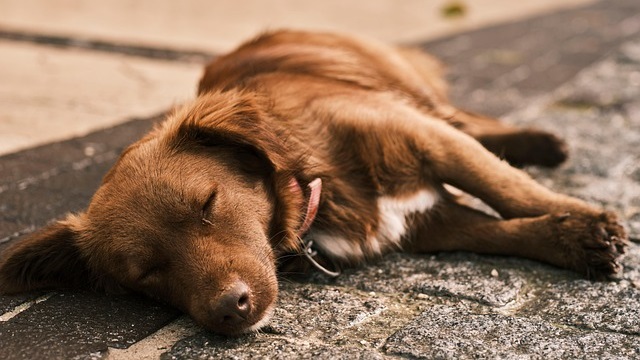
Before taking the things to the vet, consider trying some home remedies to alleviate discomfort in the paw and prevent excessive licking. First up, it’s the good ol’ cleaning of the paws after a walk to remove dirt.
Next up are the paw balms. These home remedies will serve as barrier-repair products, also known as topical emollients. For example, lanolin is there to help soften dry and cracked pads. In case of smaller wounds or scratches, you could try a 0.05% chlorhexidine solution to cleanse the wounds and even remove bacteria and yeast.
Of course, if the situation doesn’t seem to improve and you start seeing redness, swelling, or the smell worsens, there’s no safe home remedy that should replace veterinary care.
The Word of an Expert
“Occasional paw licking is normal grooming behavior. But when it becomes frequent or obsessive, it can indicate allergies, infections, or stress.” – Carolina Domingues, DVM, Veterinarian at Maven Pet
Why Behavior Monitoring Matters?
Tracking how often your dog licks or scratches, you can spot patterns that might signal a deeper health problem. However, if the licking happens at night or when you’re out, it is tough to keep track, and that is why a pet health tracker is a tool that you need to look to for help.
How Maven Can Help Identify and Track Itching Patterns
Maven Pet’s pet health app is your biggest ally in identifying excessive paw licking and itching. The AI-powered system continuously tracks your dog’s activity, including itch-related and licking behaviors, then analyzes the data to flag anything unusual.
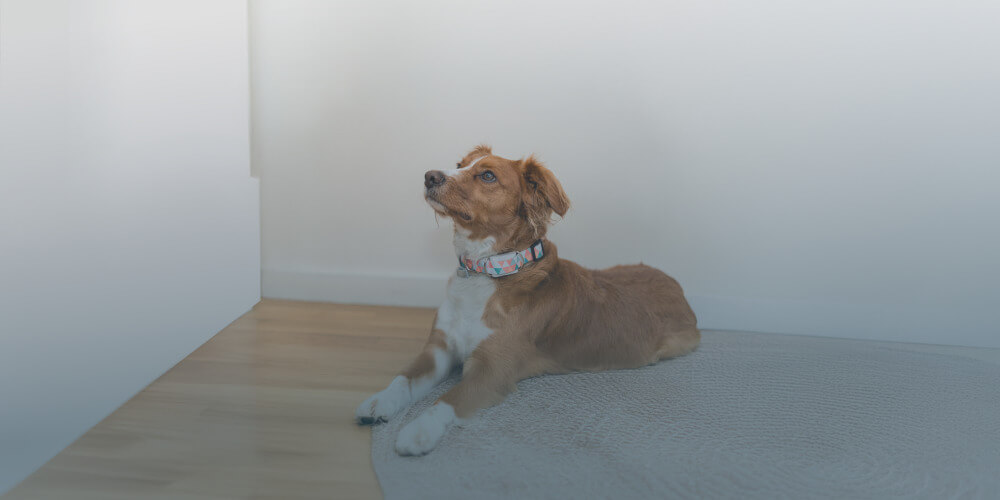
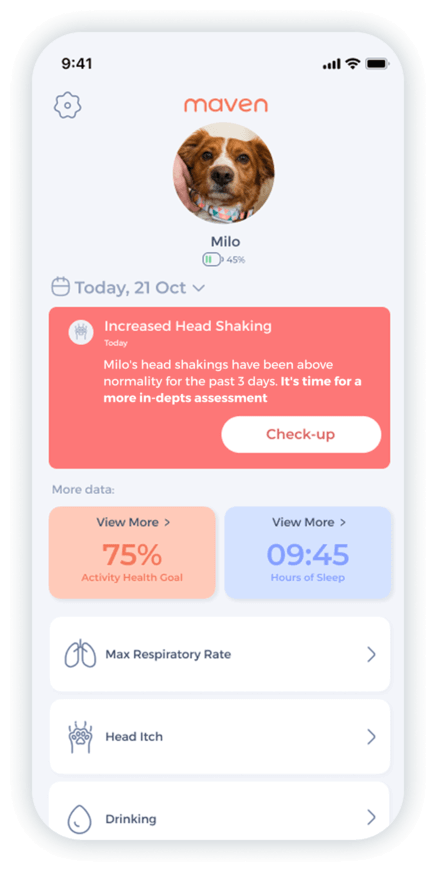
Monitor heart rate, respiratory rate, activity & rest, drinking, itch behavior.
If your dog’s licking suddenly spikes, you’ll get an alert, so you can react quickly and involve your vet before the problem escalates.
Conclusion
Paw licking in dogs can be harmless or a sign of something more serious. Now, it all depends on the cause, and we went out to show you what’s normal and how to spot the red flags early. By using tools like Maven Pet to monitor changes, you can keep your dog comfortable and healthy. When in doubt, your vet is the best source, and with the data from Maven Pet’s tracker, you can help your vet get to the bottom of things quickly.
Maven Pet focuses on improving the quality of life of our pets with technology, using artificial intelligence (AI) to enable proactive pet care. By accurately collecting and monitoring pet data 24/7 and flagging any irregularities, Maven Pet empowers pet parents and veterinarians to stay ahead of potential health issues, ensuring the well-being and longevity of our beloved companions.

